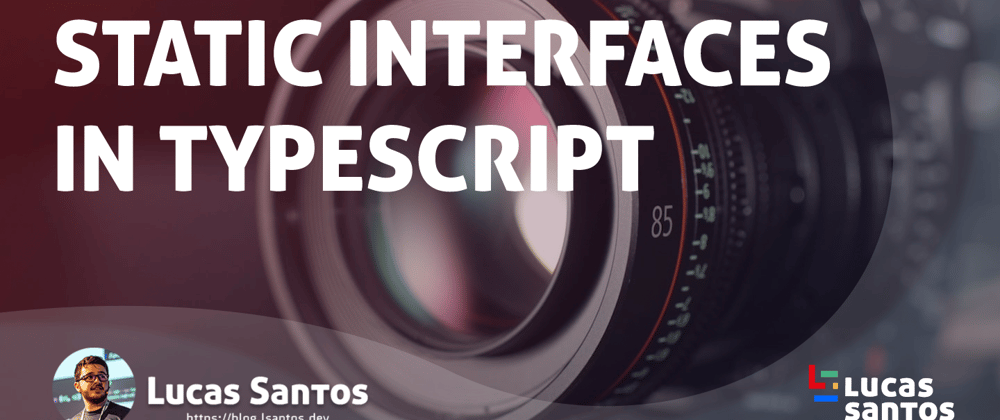Yesterday I was organizing the TS Formation classes, and I came across something quite interesting that I, myself, have struggled with for years (including yesterday).
When we talk about object-oriented programming, one of the most difficult things to understand is the concept of static properties versus instance properties, and this is especially difficult when we try to type a dynamic language on top of static typing.
I won't go into details about what static or non-static methods are in this article because there are many other contents on the Internet that you can consume that will be much more detailed than I can be here.
But it's worth it refreshing your memory.
Static methods
Static methods, or static attributes, are attributes that exist in any instance of a class, they are defined at the constructor level, that is, the class itself has these methods and therefore all instances of these classes will also have them.
A common static method is when we are creating a domain object, or a database entity, for example:
class Person {
static fromObject (obj: Record<string, unknown>) {
const instance = new Person()
instance.prop = obj.prop
return instance
}
toObject () {
return {
prop: this.prop
}
}
The fromObject method exists in all classes, it is above any instance and therefore cannot use the this keyword because this has not yet been initialized, and because you are in a context above any instance that this could refer to.
In this case, we are receiving an object and creating a new instance of the class directly with it. To execute this code, instead of doing something standard like:
const p = new Person()
p.fromObject(etc) // error, the property does not exist in the instance
We need to call the method directly from the class constructor:
const p = Person.fromObject(etc)
The problem
Static methods are very common in strongly typed languages because you have a clear separation between the static moment of the class and the "dynamic" moment.
But what happens when we need to type a dynamic language with static typing?
In TypeScript we will have some errors when we try to declare, for example, that a class has dynamic and static methods and try to describe both in an interface:
interface Serializable {
fromObject (obj: Record<string, unknown>): Person
toObject (): Record<string, unknown>
}
class Person implements Serializable
// Class 'Person' incorrectly implements interface 'Serializable'.
// Property 'fromObject' is missing in type 'Person' but required in type
// 'Serializable'.
This happens because interfaces in TypeScript act on the "dynamic side" of the class, so it is as if all interfaces were instances of the class in question, but not the class itself.
Fortunately, TypeScript has a way to declare a class as a constructor, the so-called Constructor Signatures:
interface Serializable {
new (...args: any[]): any
fromObject(obj: Record<string, unknown>): Person
toObject(): Record<string, unknown>
}
It should work now, right? Unfortunately not, because even if you implement the method manually, the class will still say that you have not implemented the fromObject method.
The problem of static reflection
And the problem goes further, for example, if we wanted to make a database class that uses the entity name straight from the class to create a file, this is done through the name property in any class, this is a static property that exists in all instantiable objects:
interface Serializable {
toObject(): any
}
class DB {
constructor(entity: Serializable) {
const path = entity.name // name does not exist in the property
}
}
Okay, so we can replace entity.name for entity.constructor.name, which works, but what about when we need to create a new entity from an object?
interface Serializable {
toObject(): any
}
class DB {
#entity: Serializable
constructor(entity: Serializable) {
const path = entity.constructor.name
this.#entity = entity
}
readFromFile() {
// we read from this file here
const object = 'file content as an object'
return this.#entity.fromObject(object) // fromObject does not exist
}
}
So, we have a choice: either we prioritize the instance, or we prioritize the constructor...
The solution
Fortunately, we have a solution to this problem. It is not very pretty, but there are some ideas in the TypeScript repository (like this one and this one) that have been analyzing the possibility of adding static definitions to interfaces since 2017.
However, since this idea hasn't arrived yet, what we have is the definition of two parts of the interface, the static part and the instance part:
export interface SerializableStatic {
new (...args: any[]): any
fromObject(data: Record<string, unknown>): InstanceType<this>
}
export interface Serializable {
id: string
toJSON(): string
}
It is important to note that the constructor in
new(...args: any[]): anyhas to be typed asanyin the return, otherwise it becomes a circular reference
With these two parts of the class typed, we can say that the class only implements the instance part:
class Person implements Serializable {
// ...
}
Now, we can say that our database will receive two types of parameters, one will be the static part, which we will call S
and the other one will be the dynamic (or instance) part, which we will call I, and S will always extend SerializableStatic
and I will always extend Serializable and, by default, will be the type of an instance of S , which can be defined by the InstanceType<S> type utility:
class Database<S extends SerializableStatic, I extends Serializable = InstanceType<S>> {}
Now we can have our properties normally, for example:
class Database<S extends SerializableStatic, I extends Serializable = InstanceType<S>> {
#dbPath: string
#data: Map<string, I> = new Map()
#entity: S
constructor(entity: S) {
this.#dbPath = resolve(dirname(import.meta.url), `.data/${entity.name.toLowerCase()}.json`)
this.#entity = entity
this.#initialize()
}
}
And in our #initialize method we will use the fromObject method to be able to read directly from the file and turn it into an instance of a class:
class Database<S extends SerializableStatic, I extends Serializable = InstanceType<S>> {
#dbPath: string
#data: Map<string, I> = new Map()
#entity: S
constructor(entity: S) {
this.#dbPath = resolve(dirname(import.meta.url), `.data/${entity.name.toLowerCase()}.json`)
this.#entity = entity
this.#initialize()
}
#initialize() {
if (existsSync(this.#dbPath)) {
const data: [string, Record<string, unknown>][] = JSON.parse(readFileSync(this.#dbPath, 'utf-8'))
for (const [key, value] of data) {
this.#data.set(key, this.#entity.fromObject(value))
}
return
}
this.#updateFile()
}
}
Also, we can have methods like get and getAll, or even save that receive and return instances only.
get(id: string): I | undefined {
return this.#data.get(id)
}
getAll(): I[] {
return [...this.#data.values()]
}
save(entity: I): this {
this.#data.set(entity.id, entity)
return this.#updateFile()
}
Now, when we use a database of this type like:
class Person implements Serializable {
// enter code here
}
const db = new DB(Person)
const all = db.getAll() // Person[]
const oneOrNone = db.get(1) // Person | undefined
db.save(new Person()) // DB<Person>
If you enjoyed this content, come and learn more about TypeScript with me in TS Formation! Just go to https://formacaots.com.br and join over 250 students who are already enjoying it!







Top comments (2)
Wouldn't it be better to write it like this instead of using
any?Also possible, in general it doesn't make a lot of difference because we won't be using the instance constructor typing in general.